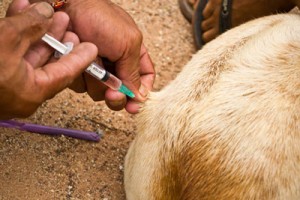World Zoonosis Day: Now is the time to take the bite out of rabies
Posted: 6 July 2015 |
Despite being preventable thanks to vaccines, over 60,000 people die from rabies each year making it one of the world’s most deadly infectious diseases…


Rabies is a zoonotic disease meaning that it can be transmitted from infected animals to humans.


It is found on all continents except for Antarctica but thanks to rabies vaccines, it is 100% preventable. Despite this, over 60,000 people still die from rabies each year making it one of the world’s most deadly infectious diseases.
To mark the fourth annual World Zoonosis Day, the global animal medicines association HealthforAnimals has joined leading voices to highlight the economic paradox of the rabies crisis and call for urgent action to halt the spread of rabies and other zoonotic diseases once and for all.
Rabies costs global economies an estimated $124 billion annually. Taking India as an example, post-bite immunisations cost the Indian economy over $25 million a year alone, yet more people die of rabies in India than anywhere else in the world. However, a rabies vaccine costs as little as £5 to vaccinate 20 dogs for one year.
There are over 200 identified zoonotic diseases
Up to 75% of all known human diseases are zoonotic in origin, and currently there are over 200 identified zoonotic diseases that represent a clear threat to human health and to the welfare of animals. To mark World Zoonosis Day, HealthforAnimals are focusing on rabies as one zoonotic disease that can be eradicated.
HealthforAnimals Executive Director, Carel du Marchie Sarvaas said, “To address the global zoonotic threat, HealthforAnimals promote the use of preventive veterinary medicines and the widespread use and development of vaccines. These play an increasingly important role in the effective control of a variety of diseases.
“However there are often barriers to implementing these technologies and the animal health industry must urgently work closely with NGOs, inter-governmental bodies, governments and regulators around the world to encourage access to medicines, in order to overcome solvable disease challenges.
“Also important, is ensuring an environment that encourages continued innovation within the animal health industry, to ensure that we remain on top of the always shifting disease-scape, as pathogens themselves, and the environment in which they exist, continually change. Preventing rabies in dogs is widely regarded as one of the best options for reducing the number of deaths in humans.”
Canine rabies can be beaten if 70% of dogs are vaccinated
Professor Louis Nel, Executive Director of the Global Alliance for Rabies Control said,“Today marks the 130th anniversary of the successful application on a human by Louis Pasteur of a vaccine for rabies. On July 6th 1885, Pasteur used the vaccine on 9 year old Joseph Meister who was badly mauled by a rabid dog. Louis Pasteur was hailed a hero and the rabies vaccine paved the way for the development of other vaccines.
“We have come a long way since then and yet we still haven’t beaten rabies in some parts of the world. We can make rabies history if international institutions invested more in mass canine vaccinations. We know we can beat canine rabies if we vaccinate 70% of dogs. Canine vaccines are not only less expensive than injections for people; they are far less expensive than the critical care treatment of a human rabies case.
“To achieve this, the animal and human health industries need to align and secure increased support and funding from international institutions for in-country rabies control programmes. Only then can we achieve a world free of rabies.”




